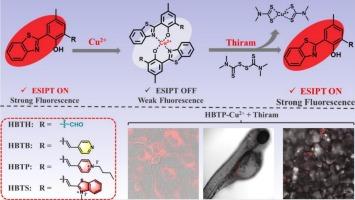Cu2+辅助的大斯托克斯位移荧光探针用于特异性成像体外和体内硫胺的积累。
IF 4.6
2区 化学
Q1 SPECTROSCOPY
Spectrochimica Acta Part A: Molecular and Biomolecular Spectroscopy
Pub Date : 2025-09-25
DOI:10.1016/j.saa.2025.126997
引用次数: 0
摘要
硫木渣具有生物蓄积性和长期环境毒性,对生态和健康具有重大危害。因此,开发特异性强、灵敏度高的检测方法是进行硫胺风险评估的关键。本文设计了以甲酰基、4-甲基吡啶(4)、4-甲基吡啶盐(5)和3-甲基-2-甲基苯并[d]噻唑-3-碘化铵(6)为修饰物的2-(苯并[d]噻唑-2-甲基)-4-甲基苯酚为基础的系列荧光探针(分别命名为HBTH、HBTB、HBTP和HBTS)。四种探针的最大发射波长分别为550 nm、600 nm、650 nm和680 nm,对Cu2+反应迅速,在2 s内形成非荧光络合物(HBTR-Cu2+, R = H, B, P, s),进一步具有“发光”能力。值得注意的是,HBTP比其他三种探针具有更好的抗洗能力,因此成功地应用于体外和体内Cu2+的鉴定。最后,HBTP-Cu2+实现了据我们所知的第一个thiram积累和分布的体内可视化,为农药残留风险评估提供了直接和可视化的策略。本文章由计算机程序翻译,如有差异,请以英文原文为准。

Cu2+-assisted fluorescent probe with large stokes shift for specific imaging the accumulation of thiram in vitro and in vivo
Thiram residue poses significant ecological and health risk due to its bioaccumulation and long-term environmental toxicity. Thus, developing specific and sensitive detection method is critical for risk assessment of thiram. Herein, a series fluorescent probes based on 2-(benzo[d]thiazol-2-yl)-4-methylphenol, which further modified with formyl, 4-methylpyridine (4), 4-methylpyridinium salt (5) and 3-methyl-2-methylbenzo [d] thiazole-3-onium iodide (6) were designed (named HBTH, HBTB, HBTP and HBTS, respectively). The four probes displayed maximum emission at 550 nm, 600 nm, 650 nm and 680 nm, respectively, and respond rapidly to Cu2+ within 2 s to forming a non-fluorescent complex (HBTR-Cu2+, R = H, B, P, S), further for detecting thiram with “light up” ability. Notably, HBTP displayed superior anti-wash capability over other three probes, thus successfully applied to identify Cu2+ in vitro and in vivo. Finally, HBTP-Cu2+ has achieved the first in vivo visualization of thiram accumulation and distribution to our knowledge, providing a direct and visualized strategy to assess pesticide residue risks.
求助全文
通过发布文献求助,成功后即可免费获取论文全文。
去求助
来源期刊
CiteScore
8.40
自引率
11.40%
发文量
1364
审稿时长
40 days
期刊介绍:
Spectrochimica Acta, Part A: Molecular and Biomolecular Spectroscopy (SAA) is an interdisciplinary journal which spans from basic to applied aspects of optical spectroscopy in chemistry, medicine, biology, and materials science.
The journal publishes original scientific papers that feature high-quality spectroscopic data and analysis. From the broad range of optical spectroscopies, the emphasis is on electronic, vibrational or rotational spectra of molecules, rather than on spectroscopy based on magnetic moments.
Criteria for publication in SAA are novelty, uniqueness, and outstanding quality. Routine applications of spectroscopic techniques and computational methods are not appropriate.
Topics of particular interest of Spectrochimica Acta Part A include, but are not limited to:
Spectroscopy and dynamics of bioanalytical, biomedical, environmental, and atmospheric sciences,
Novel experimental techniques or instrumentation for molecular spectroscopy,
Novel theoretical and computational methods,
Novel applications in photochemistry and photobiology,
Novel interpretational approaches as well as advances in data analysis based on electronic or vibrational spectroscopy.

 求助内容:
求助内容: 应助结果提醒方式:
应助结果提醒方式:


